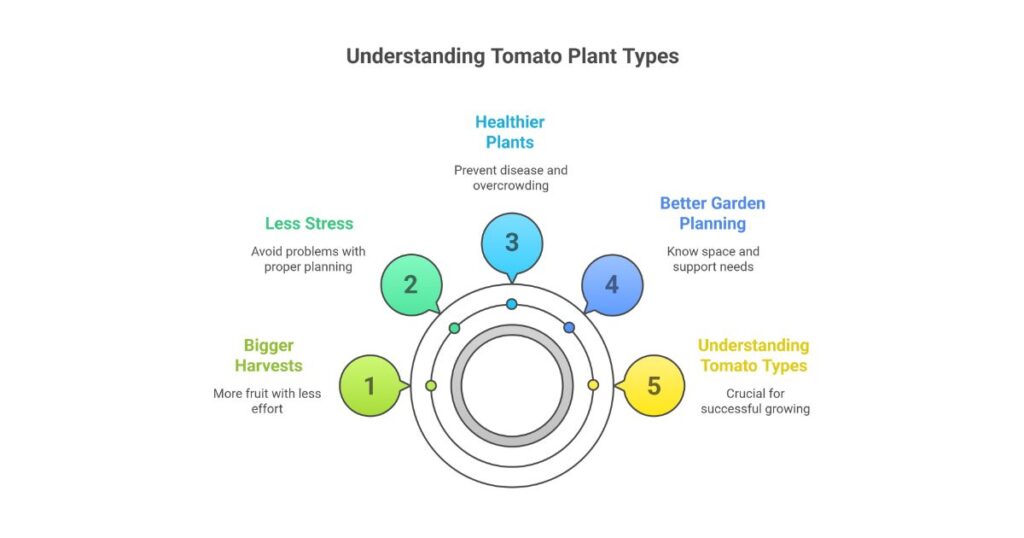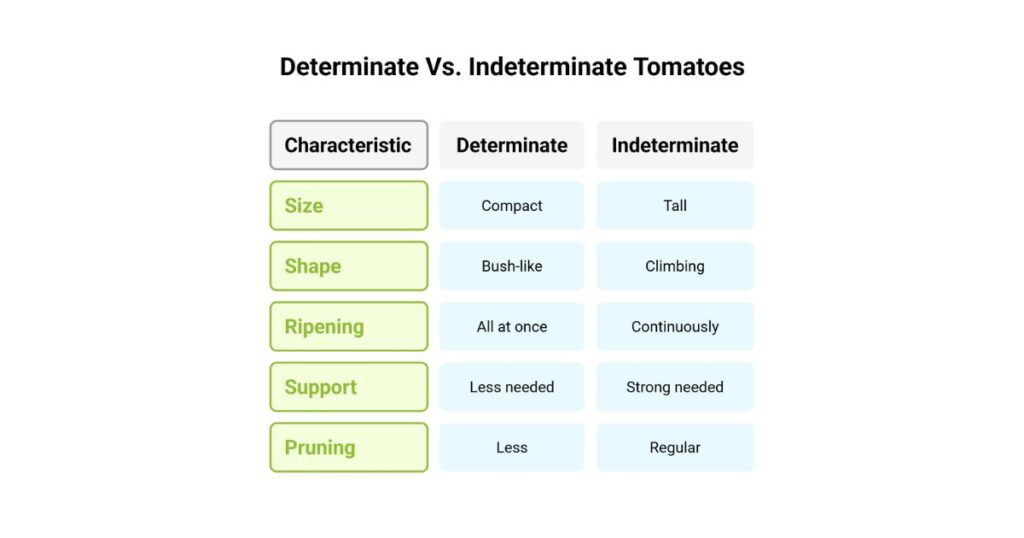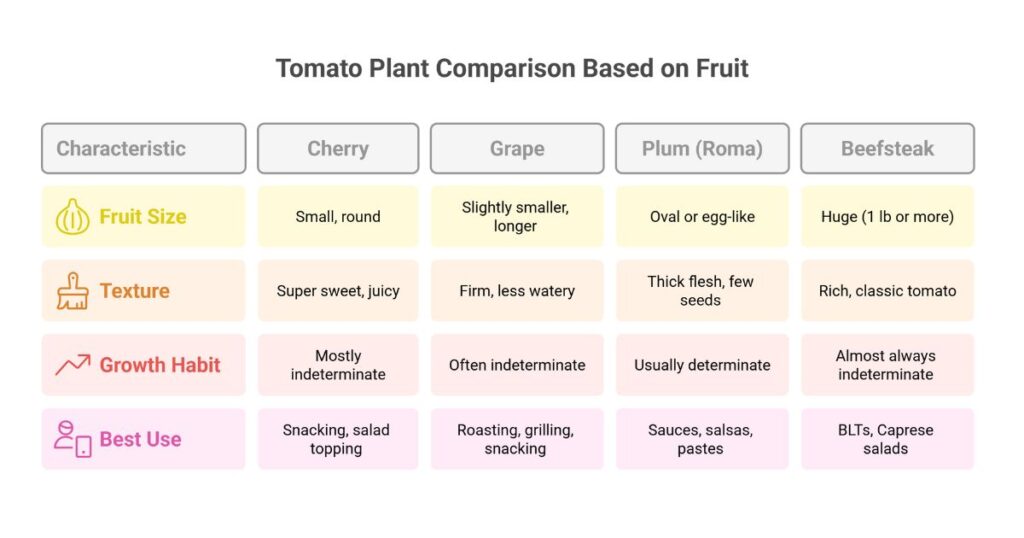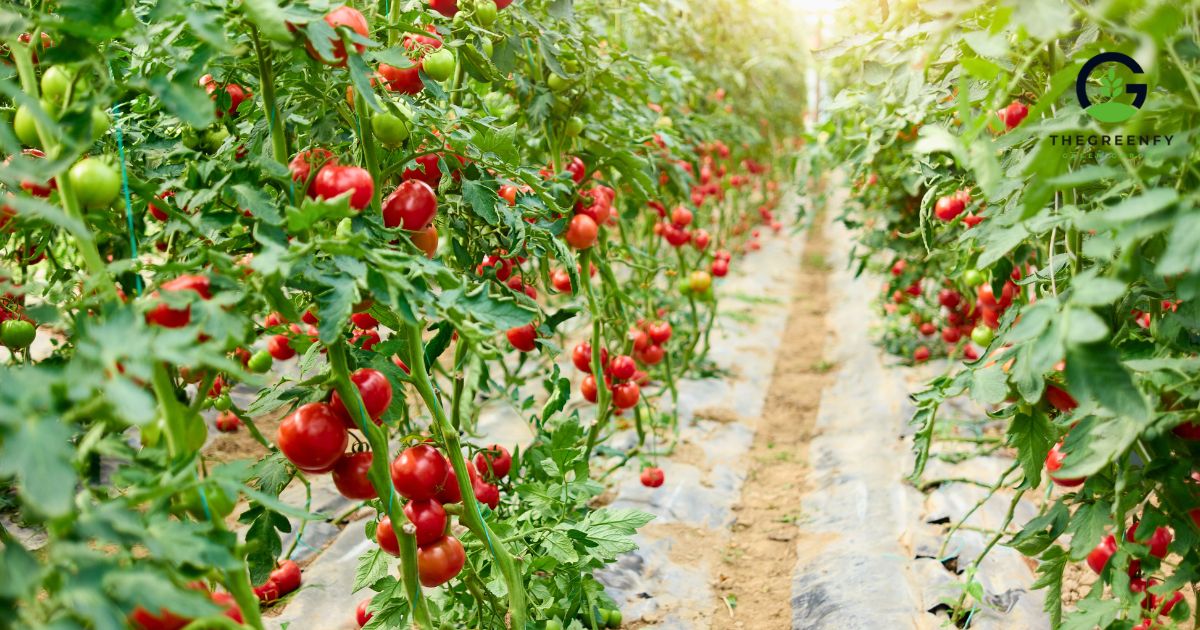Tomatoes are like the stars of any home garden. They’re juicy, colorful, versatile, and oh-so-delicious. But here’s the thing not all tomato plants are the same. In fact, there are dozens of types, each with its own personality.
Some grow tall and wild. Others stay neat and compact. Some love to sprawl under the sun, while others thrive in hanging baskets. Confused about where to start?
Don’t worry—this guide breaks down all the types of tomato plants you’ll come across. Whether you’re growing in a backyard, on a balcony, or in a container, there’s a perfect tomato plant waiting for you.
Why Understanding Tomato Plant Types Matters

Think all tomato plants are the same? Think again.
There’s a big difference between a tomato plant that gives you one giant harvest and one that keeps pumping out juicy fruit all summer long. Some love containers.
Others stretch like wild vines. And if you don’t know what you’re planting, your garden might turn into a tangled mess or worse, produce disappointing fruit.
Here’s why it’s crucial to know the type of tomato you’re growing:
- Better garden planning: You’ll know how much space, support, and time each plant needs.
- Healthier plants: Picking the right type helps prevent disease, pests, and overcrowding.
- Bigger harvests: The right match means more fruit with less effort.
- Less stress: You won’t spend hours trying to fix problems that could have been avoided.
Let’s be real: gardening should be fun, not frustrating. Choosing the right tomato plant type sets you up for success from day one.
Imagine buying a tiny seedling, planting it in a small pot, and waking up two months later to find it towering over your balcony railing like a jungle vine. That’s what happens when you don’t know if it’s a determinate or indeterminate tomato plant.
So before you start digging, let’s understand the two main categories.
The Two Main Categories of Tomato Plants

All tomato plants fall into one of two main growth types: determinate and indeterminate. These terms might sound scientific, but don’t worry—they’re actually pretty simple once you break them down.
Let’s compare them:
1. Determinate Tomatoes (The Bushy Ones)
Determinate tomato plants grow to a fixed size. They stop growing once they set fruit at the top of the plant.
Key Traits:
- Compact size – Usually 2 to 4 feet tall
- Bush-like shape – Doesn’t sprawl endlessly
- Fruits all ripen at once – Great for canning or big harvests
- Less pruning needed
- Usually don’t need cages (though small support helps)
Popular Varieties:
- Roma
- Celebrity
- Bush Early Girl
Perfect for:
- Small garden spaces
- Container gardening
- Cooks who want to make sauce or preserve tomatoes in batches
Pro Tip: Because they ripen all their fruit around the same time, you’ll get a big burst of tomatoes in one go but not much after that. If you love steady harvesting, you might want to plant both determinate and indeterminate types.
2. Indeterminate Tomatoes (The Climbers)
Indeterminate tomato plants just keep growing—like, forever. They’ll climb, twist, and tangle their way through the whole season unless stopped by frost or pruning.
Key Traits:
- Grow tall – 6 feet or more is common
- Produce fruit continuously – From mid-summer to first frost
- Need strong support – Cages, trellises, or stakes
- Regular pruning recommended – To keep growth under control
Popular Varieties:
- Brandywine
- Sungold
- Big Boy
Perfect for:
- Gardeners with space and time
- Those who want fresh tomatoes all season
- Anyone aiming for maximum fruit output
Pro Tip: These plants can take over if you let them. Make sure to train and support them early so they don’t overwhelm nearby plants.
Other Tomato Plant Types by Growing Style

Once you know the difference between determinate and indeterminate tomatoes, it’s time to dig deeper.
Not all tomato plants grow the same way even within those two main categories. Some are bred for tiny spaces.
Others are passed down through generations. Some are super tough and dependable, while others are flavorful divas.
Let’s explore four more ways tomato plants are grouped based on how they grow, where they thrive, and what makes them unique.
3. Dwarf Tomato Plants
Think of dwarf tomato plants as the cute and compact cousins in the tomato family.
They don’t grow tall, they don’t take over your yard, and they’re perfect for small spaces like patios, balconies, or even sunny windowsills.
What Makes Them Special:
- Size: Usually grow to about 1–2.5 feet tall
- Growth Habit: Can be determinate or indeterminate
- Fruit: Small to medium-sized tomatoes
- Maintenance: Minimal pruning needed
Popular Varieties:
- Tiny Tim
- Red Robin
- Balconi Yellow
- Dwarf Arctic Rose
Why You’ll Love Them:
- Fit in tight spots
- Require little support
- Great for beginners or lazy gardeners (no shame!)
Gardener Tip: Despite their size, dwarf tomatoes still love full sun and good soil. Don’t assume small means low maintenance, keep them fed and watered!
4. Container Tomato Plants
No backyard? No problem.
Container tomato plants are made for you.
They’re specially bred to thrive in pots, raised beds, grow bags, and other small-space setups. Whether you have a balcony, rooftop, or just a sunny porch, you can still enjoy homegrown tomatoes.
Key Characteristics:
- Compact root systems
- Usually determinate for predictable growth
- Shorter vines that won’t take over your space
- Work well in 5-gallon containers or larger
Top Varieties:
- Bush Early Girl
- Patio Princess
- Glacier
- Window Box Roma
Tips for Container Success:
- Use well-draining potting mix, not garden soil
- Place containers where they’ll get at least 6 hours of sun
- Water consistently, containers dry out fast
- Add mulch or a drip tray to help keep roots moist
Pro Tip: Choose self-watering planters or install a simple drip system to avoid the dreaded wilt during hot days.
5. Heirloom Tomato Plants
Love rich flavor and unique looks? Heirloom tomatoes are your jam.
These tomatoes aren’t just plants—they’re stories passed down from generation to generation. They’re open-pollinated, non-hybrid, and often prized for their unbeatable taste, variety, and color.
What Defines a Heirloom Tomato?
- Open-pollinated: Seeds grow true to type
- Age: Usually at least 50 years old
- Flavor: Exceptional taste and texture
- Colors: Wild! Red, yellow, purple, green, striped…
Famous Heirloom Varieties:
- Brandywine
- Cherokee Purple
- Green Zebra
- Black Krim
- Mortgage Lifter
Why Heirlooms Are Special:
- Packed with flavor
- Great for fresh eating and slicing
- Beautiful on the plate and in the garden
- You can save seeds year after year
But a heads-up:
Heirlooms tend to be less disease-resistant than hybrids. They need a little extra love and attention but reward you with tomatoes that actually taste like tomatoes.
6. Hybrid Tomato Plants
Need strong, dependable plants that don’t give you a hard time? Go hybrid.
Hybrid tomatoes are cross-bred between two different varieties to bring out the best qualities in both, like disease resistance, uniform size, and longer shelf life.
They’re not genetically modified (GMO). Instead, they’re naturally bred through careful selection.
Why Gardeners Love Hybrids:
- Consistent performance year after year
- Higher yields with less fuss
- More resistant to common tomato diseases
- Fruits look uniform and picture-perfect
Top Hybrid Choices:
- Better Boy
- Big Beef
- Early Girl
- Juliet
- Celebrity
Best For:
- Beginners who want a low-risk first try
- Gardeners in humid or disease-prone areas
- Anyone who wants a steady harvest without the drama
Note: You can’t save seeds from hybrids and expect the same plant next year. For that, stick to heirlooms or open-pollinated types.
Tomato Plants Based on Fruit Type

We’ve talked about how tomato plants grow, but what about what they grow—the tomatoes themselves?
Tomatoes come in all shapes, sizes, and flavors. From bite-sized sweet treats to giant juicy slicers, the type of fruit a tomato plant produces matters just as much as how the plant grows.
Let’s explore four of the most popular types based on fruit style: cherry, grape, plum (Roma), and beefsteak.
7. Cherry Tomato Plants
Cherry tomatoes are the candy of the garden.
They’re small, round, and incredibly sweet—perfect for popping in your mouth like snacks. These plants are often vigorous growers that produce clusters of tiny tomatoes all season long.
What Makes Them Great:
- Fruit Size: Small, round (about the size of a cherry or marble)
- Taste: Super sweet and juicy
- Growth Habit: Mostly indeterminate, but some determinate options exist
- Harvest: Heavy and continuous
Top Varieties:
- Sweet 100
- Sungold
- Black Cherry
- Tiny Tim (for containers)
Why Gardeners Love Cherry Tomatoes:
- Fast producers – many start ripening early in the season
- High yields – often the most prolific tomato type
- Low effort – great for beginners
- Kids love them – they’re fun, tasty, and bite-sized
Perfect for: Snacking, salad topping, or just eating fresh off the vine.
Gardening Tip: These plants can grow wild if left unchecked. Use cages or stakes and prune lightly to manage their bushy nature.
8. Grape Tomato Plants
Grape tomatoes are the tougher, meatier cousin of cherry tomatoes.
They’re oval-shaped, firm, and have a longer shelf life, making them popular in grocery stores and home gardens alike.
Key Features:
- Fruit Size: Slightly smaller and longer than cherry tomatoes
- Texture: Firm and less watery
- Flavor: Mildly sweet, with a subtle crunch
- Growth: Often indeterminate and very productive
Popular Varieties:
- Juliet
- Sweet Hearts
- Red Grape
- Nova
What Makes Them Special:
- Less splitting – skin holds up better than cherries
- Long shelf life – store well in the fridge
- Great for cooking – they hold shape in stir-fries and roasting
- Perfect for meal prep – toss them in lunch boxes, pastas, or side dishes
Perfect for: Roasting, grilling, snacking, or tossing in salads with vinaigrette.
Tip for Growers: Grape tomato plants love sun and heat. Keep them well-pruned to allow airflow and avoid mildew issues.
9. Plum or Roma Tomato Plants
Meet the kitchen workhorses.
Plum or Roma tomatoes are meaty, low in juice, and absolutely ideal for sauces, salsas, and pastes. These aren’t meant for snacking—they’re built for cooking.
What Sets Them Apart:
- Shape: Oval or egg-like
- Texture: Thick flesh with few seeds
- Taste: Rich and mild
- Water Content: Low (great for thick sauces)
- Growth Habit: Usually determinate, but some indeterminate types exist
Go-To Varieties:
- Roma VF
- San Marzano
- Amish Paste
- Heinz 2653
Why They’re a Kitchen Favorite:
- Best for sauces – they reduce into thick, rich textures
- Easy to peel – thanks to the firm skin
- High in solids – which means less water and more substance
- Efficient to grow – many varieties produce all fruit at once
Perfect for: Homemade marinara, tomato paste, pizza sauce, salsa, and ketchup.
Grower’s Tip: Since most plum tomatoes are determinate, expect a big harvest at once. Be ready to cook, can, or freeze them fast!
10. Beefsteak Tomato Plants
The heavyweight champions of the tomato world.
Beefsteak tomatoes are large, juicy, and full of old-fashioned tomato flavor. Just one slice can cover an entire sandwich. If you love big, juicy tomatoes—these are your best bet.
What Makes Them Bold:
- Size: Huge—often 1 lb. or more per tomato
- Shape: Round, slightly flattened, and sometimes ribbed
- Flavor: Rich, classic tomato taste
- Growth Habit: Almost always indeterminate
- Color Variety: Red, pink, yellow, orange, green, and striped
Fan-Favorite Varieties:
- Big Beef
- Brandywine
- Cherokee Purple
- Pineapple
- German Johnson
Why Gardeners Can’t Get Enough:
- Amazing fresh – for burgers, sandwiches, or slicing with a bit of salt
- Impressive size – fun to grow and show off
- Delicious flavor – bold, rich, and juicy
- Slow ripening – but worth the wait
Perfect for: BLTs, Caprese salads, tomato toast, and summer sandwiches.
Helpful Tip: These plants get huge, so give them plenty of space and support. Use strong cages or tall stakes to hold them upright and off the ground.
How to Choose the Right Tomato Plant for You
So you’ve seen the options, bushy or vining, cherry or beefsteak, heirloom or hybrid. Now the big question: Which tomato plant should YOU grow?
Choosing the right tomato plant is like choosing the right outfit. It depends on the occasion, the weather, and how much effort you want to put in. The good news? There’s a tomato plant for everyone.
Let’s break it down step by step.
1. Consider Your Growing Space
The first question to ask yourself is: Where will this tomato plant live?
- Small space?
Stick to dwarf, determinate, or container-friendly varieties. They won’t take over and are easy to manage on a patio, balcony, or even a sunny windowsill.- Try: Tiny Tim, Patio Princess, Roma
- Big backyard or raised beds?
Go for indeterminate plants that need room to grow tall and wide. They’ll reward you with months of juicy tomatoes.- Try: Brandywine, Cherokee Purple, Big Beef
2. Think About How Much Time You Can Give
Are you someone who loves fussing in the garden, or do you want low effort and big results?
- Low-maintenance gardener?
Determinate types are your best friend. They need less pruning, produce in a short window, and won’t overwhelm your space.- Try: Celebrity, Bush Early Girl, Roma
- Don’t mind hands-on care?
Indeterminate plants need staking, pruning, and a bit more attention—but they reward you with non-stop fruit until frost.- Try: Sungold, Black Krim, Big Boy
3. Match Your Tomato to Your Purpose
What are you actually going to do with your tomatoes?
- Want sweet snacks for salads?
Cherry or grape tomatoes are best.- Try: Sweet 100, Juliet, Sungold
- Love to cook sauces and soups?
Go with meaty plum or Roma tomatoes.- Try: San Marzano, Amish Paste, Roma VF
- Sandwich or burger addict?
You’ll need large, juicy beefsteak varieties.- Try: Brandywine, German Johnson, Big Beef
4. Consider Your Climate
- Hot, humid regions:
Choose disease-resistant hybrids like Better Boy, Big Beef, or Celebrity. - Cooler or shorter seasons:
Pick early maturing varieties such as Early Girl, Glacier, or Stupice.
5. Decide Between Heirloom vs. Hybrid
- Heirloom tomatoes are for flavor lovers and seed savers. But they can be more sensitive to pests and disease.
- Hybrid tomatoes are bred for productivity, resistance, and ease.
If you’re a beginner or just want reliable harvests without surprises, go hybrid. If you’re in it for flavor and variety, give heirlooms a try.
Top Tomato Plants for Beginners
Just starting your tomato-growing journey? Awesome! You don’t need to overthink it. Some tomato varieties are specifically known for being beginner-friendly—which means they’re:
- Easy to grow
- Disease-resistant
- Productive
- Forgiving (even if you mess up a little)
Here are some of the best tomato plants for first-time growers:
1. Celebrity (Hybrid – Determinate)
- Why it’s great: Resists many common tomato diseases
- Fruit size: Medium (great for slicing)
- Growth: Bushy and compact
- Harvest: One big flush of tomatoes
This plant is low-fuss, reliable, and tasty. Great for anyone who wants tomatoes without the drama.
2. Sweet 100 (Cherry – Indeterminate)
- Why it’s great: Extremely productive and super sweet
- Fruit size: Small, bite-sized
- Growth: Tall and vining (needs support)
- Harvest: Nonstop throughout the season
If you want something that just keeps going and is fun to snack on, this one’s for you.
3. Roma (Plum – Determinate)
- Why it’s great: Classic cooking tomato
- Fruit size: Medium and oval
- Growth: Compact and tidy
- Harvest: One-time, heavy yield
Great choice if you’re into pasta, sauces, or canning.
4. Early Girl (Hybrid – Indeterminate)
- Why it’s great: One of the fastest producers
- Fruit size: Medium, round tomatoes
- Growth: Needs staking
- Harvest: Early and long-lasting
Perfect if you’re eager to enjoy your tomatoes before summer ends.
5. Tiny Tim (Dwarf Cherry – Determinate)
- Why it’s great: Super small—ideal for containers
- Fruit size: Small red cherries
- Growth: Grows just 12–18 inches tall
- Harvest: Compact but surprisingly generous
This is perfect if you have a small space or want to grow indoors with a grow light.
FAQs About Types of Tomato Plants
Q1: What is the easiest tomato plant to grow for beginners?
A: Celebrity and Roma tomatoes are both beginner-friendly, disease-resistant, and don’t require much maintenance.
Q2: Can I grow indeterminate tomatoes in containers?
A: Yes, but you’ll need large containers (10+ gallons) and good support like tall stakes or cages.
Q3: How can I tell if a tomato plant is determinate or indeterminate?
A: Check the plant label or seed packet. If it keeps growing tall and producing fruit all season, it’s indeterminate.
Q4: What’s the best tomato plant for sauces?
A: Roma, San Marzano, and other plum types are meaty and low in seeds—perfect for thick sauces.
Q5: Are hybrid tomatoes genetically modified (GMO)?
A: No, hybrids are naturally cross-bred for traits like disease resistance. GMO tomatoes are different and rare in home gardening.
Conclusion: What Type of Tomato Plant Will You Grow?
From bushy determinates to towering indeterminates, the world of tomato plants is more exciting than most people think.
Your perfect plant depends on your space, time, and taste preferences. Whether you’re into sauces, salads, or snackable sweet treats, there’s a tomato type made just for you.
So go ahead—get your hands dirty. Your dream tomato harvest is just a season away.










